FEDERAL COURT OF AUSTRALIA
Lansen on behalf of the Guyal Manaburru, Burdal Mingkanyi, Burdal Riley, Murrungun Wunubari, Murrungun Baluganda/Langgabany, Mambali Walangara, Mambali Ngubayin and Mambali Nangguya Estate Groups v Northern Territory of Australia [2021] FCA 718
ORDERS
DATE OF ORDER: |
THE COURT NOTES THAT:
A. On 1 August 2017, the Applicant filed a native title determination application over the land and waters within the bounds of the Nathan River Pastoral Lease (Pastoral Lease No. 756) (the “Application”). This land now comprises Crown Land comprising part of the Limmen National Park.
B. The Applicant and the Respondents to this proceeding (the “Parties”) have reached agreement as to the terms of a proposed determination of native title in relation to the land and waters covered by the Application.
C. Acting under ss 87(1)(a)(i) and 87(1)(b) of the Act, the Parties have filed in the Court their agreement in writing (the “Determination”).
D. The external boundaries of the area subject to the Determination are described in Schedule A of the Determination and are depicted on the map comprising Schedule B of the Determination (the “Determination Area”).
E. The terms of the Parties’ agreement involve the making of consent orders pursuant to ss 87 and 94A of the Act, that native title exists in relation to the Determination Area as provided by the Determination.
F. The Parties acknowledge that the effect of making the Determination will be that the members of the native title claim group are, in accordance with the traditional laws acknowledged and the traditional customs observed by them, recognised as the native title holders for the Determination Area as provided by the Determination.
G. The Parties request that the Court determine this proceeding in accordance with their agreement.
BEING SATISFIED that a determination of native title in the terms of the Determination in respect of the proceeding is within the power of the Court and, it appearing to the Court appropriate to do so, pursuant to s 87 of the Act and by the consent of the Parties:
THE COURT ORDERS THAT:
1. There be a determination of native title in terms of the Determination set out below.
2. The native title is not to be held on trust.
3. The Top End (Default PBC/CLA) Aboriginal Corporation be appointed as the prescribed body corporate for the purposes of s 57(2) of the Act in respect of the area the subject of the Determination.
4. There be no order as to costs.
5. The Parties have liberty to apply to establish the precise location and boundaries of public works and adjacent land and waters identified in relation to any part or parts of the Determination Area referred to in Schedule D of this Determination.
THE COURT DETERMINES THAT:
The Determination Area
1. The Determination Area is the land and waters described in Schedule A hereto and depicted on the map comprising Schedule B.
2. Native title exists in those parts of the Determination Area identified in Schedule C.
3. Native title does not exist in those parts of the Determination Area identified in Schedule D.
4. In the event of any inconsistency between a description of an area in a schedule and the depiction of that area on the map in Schedule B, the written description will prevail.
The native title holders
5. The land and waters of the Determination Area comprise the whole or part of 8 estates, which are held respectively by the members of the following estate groups:
(a) the Guyal Manaburru estate group;
(b) the Burdal Mingkanyi estate group;
(c) the Burdal Riley estate group;
(d) the Murrungun Wunubari estate group;
(e) the Murrungun Baluganda/Langgabany estate group;
(f) the Mambali Walangara estate group;
(g) the Mambali Ngubayin estate group; and
(h) the Mambali Nangguya estate group.
These persons, together with the Aboriginal people referred to in clause 7, are collectively referred to as the “native title holders”.
6. Each of the estate groups referred to in clause 5 includes persons who are members of the group by reason of:
(a) patrilineal descent;
(b) his or her mother, father’s mother or mother’s mother being or having been a member of the group by reason of patrilineal descent; or
(c) having been adopted or incorporated into the descent relationships referred to in (a) or (b) above.
These persons are collectively referred to as the “estate group members”.
7. In accordance with the traditional laws acknowledged and the traditional customs observed by the estate group members, other Aboriginal people have native title rights and interests in respect of the Determination Area, subject to the native title rights and interests of the estate group members, such people being:
(a) members of estate groups from neighbouring estates; and
(b) spouses of the estate group members.
8. Each of the estate groups referred to in clause 7(a) includes persons who are members of the group by reason of:
(a) patrilineal descent;
(b) his or her mother, father’s mother or mother’s mother being or having been a member of the group by reason of patrilineal descent; or
(c) having been adopted or incorporated into the descent relationships referred to in (a) or (b) above.
The native title rights and interests
9. The native title rights and interests of the estate group members referred to in clause 5 in relation to those parts of the Determination Area identified in Schedule C, being an area where there has been partial extinguishment of native title, are the rights:
(a) to access, remain on and use the areas;
(b) to access and to take for any purpose the resources of areas; and
(c) to protect places, areas and things of traditional significance.
10. The native title rights and interests of the persons referred to in clause 7 above in relation to those parts of the Determination Area identified in Schedule C, being an area where there has been partial extinguishment of native title, are the rights:
(a) to access, remain on and use the areas; and
(b) to access the resources of the areas.
11. The native title rights and interests do not confer on the native title holders:
(a) possession, occupation, use and enjoyment of those parts of the Determination Area identified in Schedule C to the exclusion of all others;
(b) any right to control the access to and use of those parts of the land and waters of the areas or their resources;
(c) any right to access or take resources that are the private or personal property of another, including but not limited to:
(i) infrastructure or fixtures; and
(ii) chattels, equipment, machinery or supplies.
12. The native title rights and interests are subject to and exercisable in accordance with:
(a) the traditional laws and customs of the native title holders; and
(b) the laws of the Northern Territory of Australia and the Commonwealth of Australia.
13. There are no native title rights and interests in:
(a) minerals (as defined in s 2 of the Minerals (Acquisition) Act 1953 (NT));
(b) petroleum (as defined in s 5 of the Petroleum Act 1984 (NT)); or
(c) prescribed substances (as defined in s 3 of the Atomic Energy (Control of Materials) Act 1946 (Cth) and/or s 5(1) of the Atomic Energy Act 1953 (Cth)),
in the Determination Area.
Non-exhaustive List of Activities
14. Without limiting the native title rights and interests described in clauses 9 and 10 in any way, and without purporting to describe exhaustively the activities which those rights authorise or permit, the rights and interests referred to in clause 9 enable the estate group members referred to in clause 5 to:
(a) travel over, move about and access those areas;
(b) hunt and fish on the land and waters of those areas;
(c) gather and to use the natural resources of those areas such as food, medicinal plants, wild tobacco, timber, stone and resin;
(d) take and to use the natural water on those areas;
(e) live and camp on the areas, and to erect shelters and other structures on those areas;
(f) light fires for domestic purposes;
(g) conduct and participate in the following activities on those areas:
(i) cultural activities;
(ii) cultural practices relating to birth and death, including burial rites;
(iii) ceremonies;
(iv) meetings;
(v) teaching the physical and spiritual attributes of sites and places on those areas that are of traditional significance;
(h) maintain and protect sites and places on those areas that are of traditional significance;
(i) be accompanied onto the land and waters by persons who, though not native title holders, are:
(i) people required by traditional law and custom for the performance of ceremonies or cultural activities on those areas;
(ii) people who have rights in relation to the areas according to the traditional laws and customs acknowledged by the estate group members; and
(iii) people required by the estate group members to assist in, observe, or record traditional activities on the areas.
Other interests in the Determination Area
15. The nature and extent of other interests in relation to the Determination Area are the interests, created by the Crown or otherwise, as follows:
(a) the interests of the Parks and Wildlife Commission of the Northern Territory (the Commission):
(i) pursuant to its power of management and control of this area under the Territory Parks and Wildlife Conservation Act 1978 (NT) (and subsidiary legislation including under any Plan of Management in force in relation to the area from time to time) and the Parks and Wildlife Commission Act 1980 (NT);
(ii) in any buildings, works or structures, including any adjacent area the use of which is or was necessary for, or incidental to, the construction, establishment or operation of the buildings, works or structures:
A. previously constructed or established by others and being occupied and/or used or maintained by or on behalf of the Commission; and
B. constructed or established by or on behalf of the Commission in these areas.
(b) the interests of members of the public arising from rights of access to and use of these areas as part of a national park, subject to any statutory limitations upon these rights including those under the Northern Territory Aboriginal Sacred Sites Act 1989 (NT);
(c) the rights and interests of persons who have the care, control and management of the following roads, which are depicted in the maps at Schedule E:
(i) Limmen River Crossing Road, Butterfly Springs Access Road, and Southern Lost City Access Road (where, for the purposes of this determination, the area of each Road is co-extensive with a 70m-wide corridor, 35m either side of the centreline of the Road); and
(ii) Western Lost City Access Road, Catfish Waterhole Access Road, and Four Archers Road (where, for the purposes of this determination, the area of each road is coextensive with a 40m-wide corridor, 20m either side of the centreline of the road);
(d) the interests of members of the public entitled to access and use the Roads identified in subclause (c), subject to any statutory limitations upon those rights;
(e) the rights and interests of Telstra Corporation Limited:
(i) as the owner or operator of telecommunications facilities within the Determination Area;
(ii) created pursuant to the Post and Telegraph Act 1901 (Cth), the Telecommunications Act 1975 (Cth), the Australian Telecommunications Corporation Act 1989 (Cth), the Telecommunications Act 1991 (Cth) and the Telecommunications Act 1997 (Cth), including rights:
A. to inspect land;
B. to install and operate telecommunications facilities; and
C. to alter, remove, replace, maintain, repair and ensure the proper functioning of its telecommunications facilities;
(iii) for its employees, agents or contractors to access its telecommunications facilities in, and in the vicinity of, the Determination Area, in the performance of their duties; and
(iv) under any lease, licence, access agreement, permit or easement relating to its telecommunications facilities in the Determination Area;
(f) the rights of Aboriginal persons (whether or not native title holders) pursuant to the Northern Territory Aboriginal Sacred Sites Act 1989 (NT);
(g) rights of access by an employee, servant, agent or instrumentality of the Northern Territory or Commonwealth, or other statutory authority as required in the performance of statutory duties;
(h) the rights to water lawfully captured by the holders of other interests;
(i) the rights and interests of persons to whom valid and validated rights and interests have been:
(i) granted by the Crown pursuant to statute or otherwise in the exercise of executive power; or
(ii) otherwise conferred by statute;
(j) the rights and interests of the holders of the following titles granted under the Mineral Titles Act 2010 (NT) and the Petroleum Act 1984 (NT), depicted in Schedule F:
(i) Access Authority No. 29691 granted on 8 November 2012;
(ii) Extractive Mineral Permit No. 30341 granted on 7 January 2020;
(iii) Extractive Mineral Permit No. 30342 granted on 7 January 2020;
(iv) Extractive Mineral Permit No. 30345 granted on 7 January 2020;
(v) Extractive Mineral Permit No. 30346 granted on 7 January 2020;
(vi) Exploration Licence Title No. 29548 granted on 27 August 2012;
(vii) Exploration Licence Title No. 26939 granted on 9 June 2009;
(viii) Exploration Licence Title No. 30158 granted on 9 June 2009;
(ix) Exploration Permit No. 161 granted on 21 May 2012; and
(x) Exploration Permit No. 184 granted on 21 August 2013.
Relationship between the native title and other interests
16. Subject to clause 17 below, the other rights and interests referred to in clause 15(a), (b), (d)-(j), and the doing of an activity in giving effect to them or of an activity required or permitted by them, prevail over but do not extinguish the native title rights and interests referred to in clauses 9 and 10, and the existence and exercise of the native title rights and interests do not prevent the carrying on of any such activity.
17. By reason of s 12(1A) of the Territory Parks and Wildlife Conservation Act 1976 (NT), paragraph 16 does not apply to the rights and interests identified in clauses 15(a) and (b). To the extent of any inconsistency between those rights and interests identified in clauses 15(a) and (b), including the doing of any activity giving effect to, or required or permitted by them, and the native title rights and interests, the native title rights and interests prevail.
18. The non-extinguishment principle applies to the other rights and interests referred to in clause 15(c).
Definitions
19. In this determination, unless the contrary intention appears:
“the Act” means the Native Title Act 1993 (Cth);
“land” and “waters” respectively have the same meanings as in the Act;
“resources” for the purposes of clauses 9 and 10 of this Determination does not include minerals, petroleum and prescribed substances;
“the Commonwealth” means the Commonwealth of Australia; and
“the Northern Territory” means the Northern Territory of Australia.
Note: Entry of orders is dealt with in Rule 39.32 of the Federal Court Rules 2011.
SCHEDULE A
Description of Determination Area
The Determination Area comprises the following areas of land:
1. NT Portion 1334, being Crown land comprising of part of the Limmen National Park and former Pastoral Lease No. 756.
SCHEDULE B
Map of Determination Area

SCHEDULE C
Areas where native title exists
The areas of land and waters in respect of which the native title rights and interests in clauses 9 and 10 apply are:
1. NT Portion 1334, being Crown land comprising part of the Limmen National Park and former Pastoral Lease No. 756, except those parts thereof referred to in Schedule D.
SCHEDULE D
Areas where native title does not exist
Native title rights and interests have been wholly extinguished in the following areas of land and waters:
1. Those parts of the Determination Area covered by the following roads comprising public works:
(a) that part of NT Portion 1334 comprising Nathan River Road 100m wide (50m either side of the centreline) commencing from the northern boundary of NT Portion 1334 to the southern boundary of this parcel as indicated on the Determination Map at Schedule B;
(b) that part of NT Portion 1334 comprising Nathan River Homestead Access road of variable width as indicated on the Determination Map at Schedule B.
2. Those parts of the Determination Area covered by public works as defined in s 253 of the Act (including adjacent land or waters as defined in s 251D of the Act) which were constructed, established or situated prior to 23 December 1996 or commenced to be constructed or established on or before that date, including but not limited to:
(a) gravel pits adjacent to the roads referred to at paragraph 1 above used to maintain those roads;
(b) access roads or tracks to the public works referred to in this clause;
(c) Government bores and associated infrastructure including bores used for the establishment, operation or maintenance of public and other roads;
(d) river and rain gauges;
(e) transmission and distribution water pipes and associated infrastructure;
(f) sewer pipes, sewer pump stations and associated infrastructure; and
(g) electricity transmission lines, towers, poles and associated infrastructure.
SCHEDULE E
Maps of Roads described above at clause 15(c)
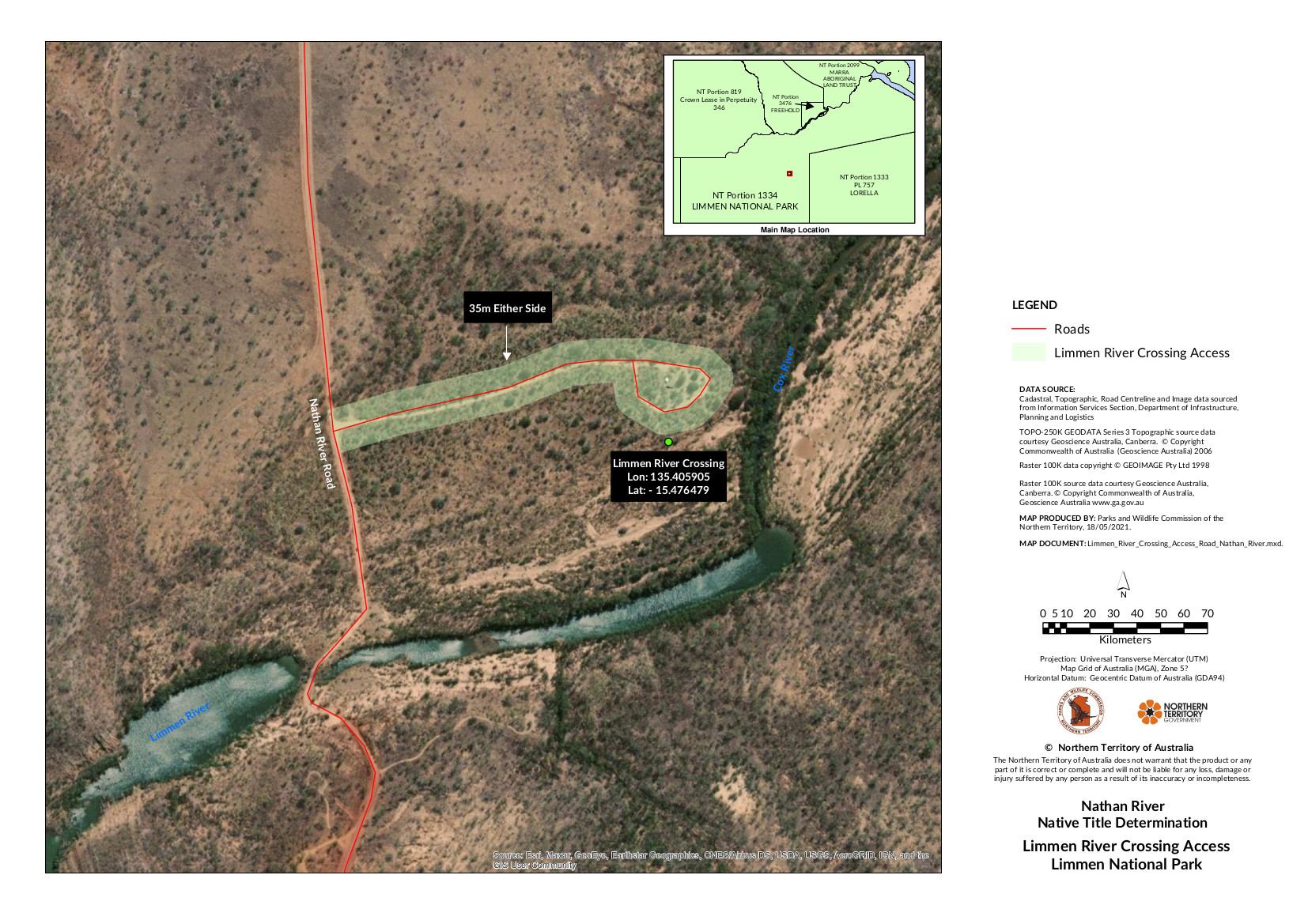
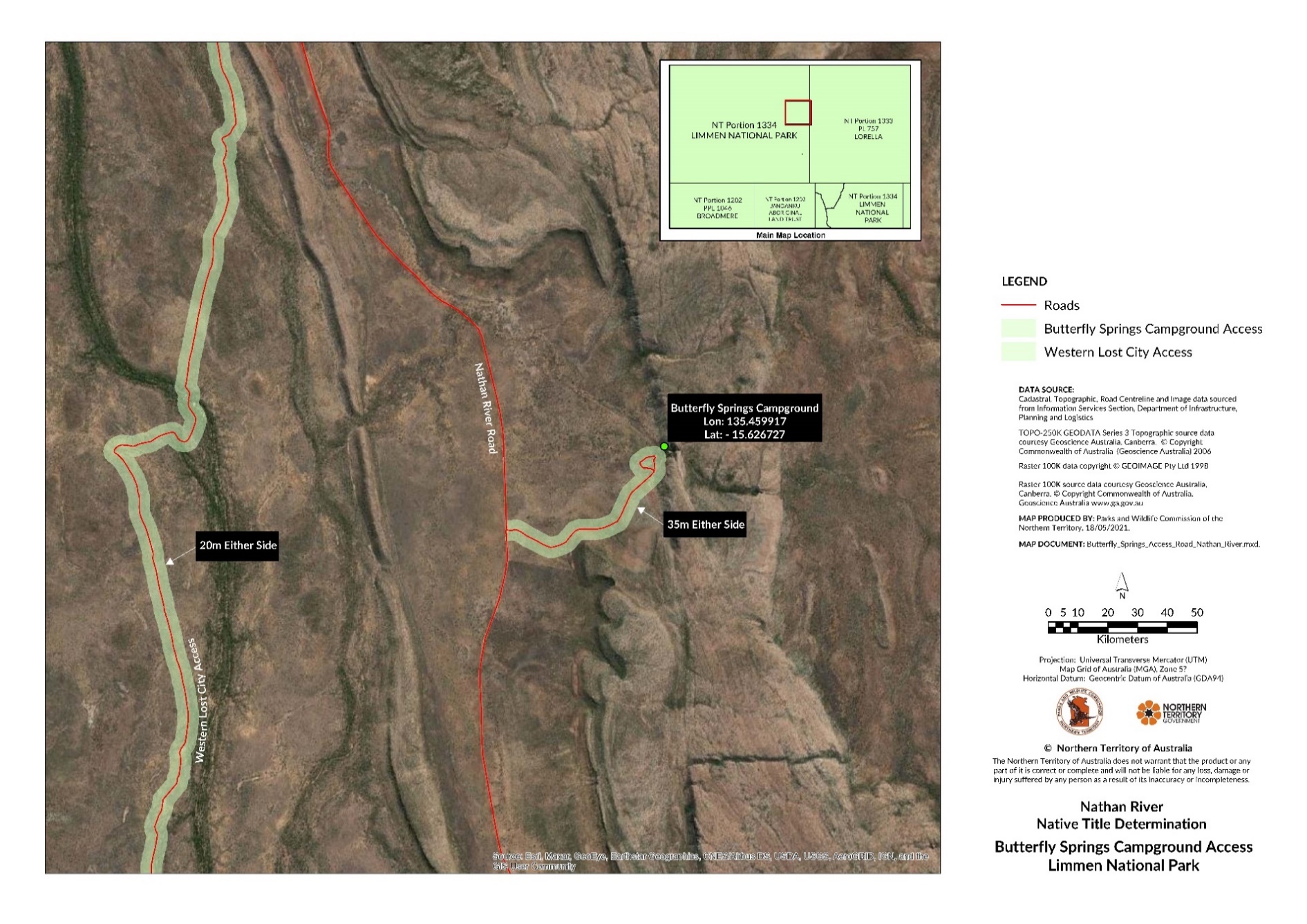
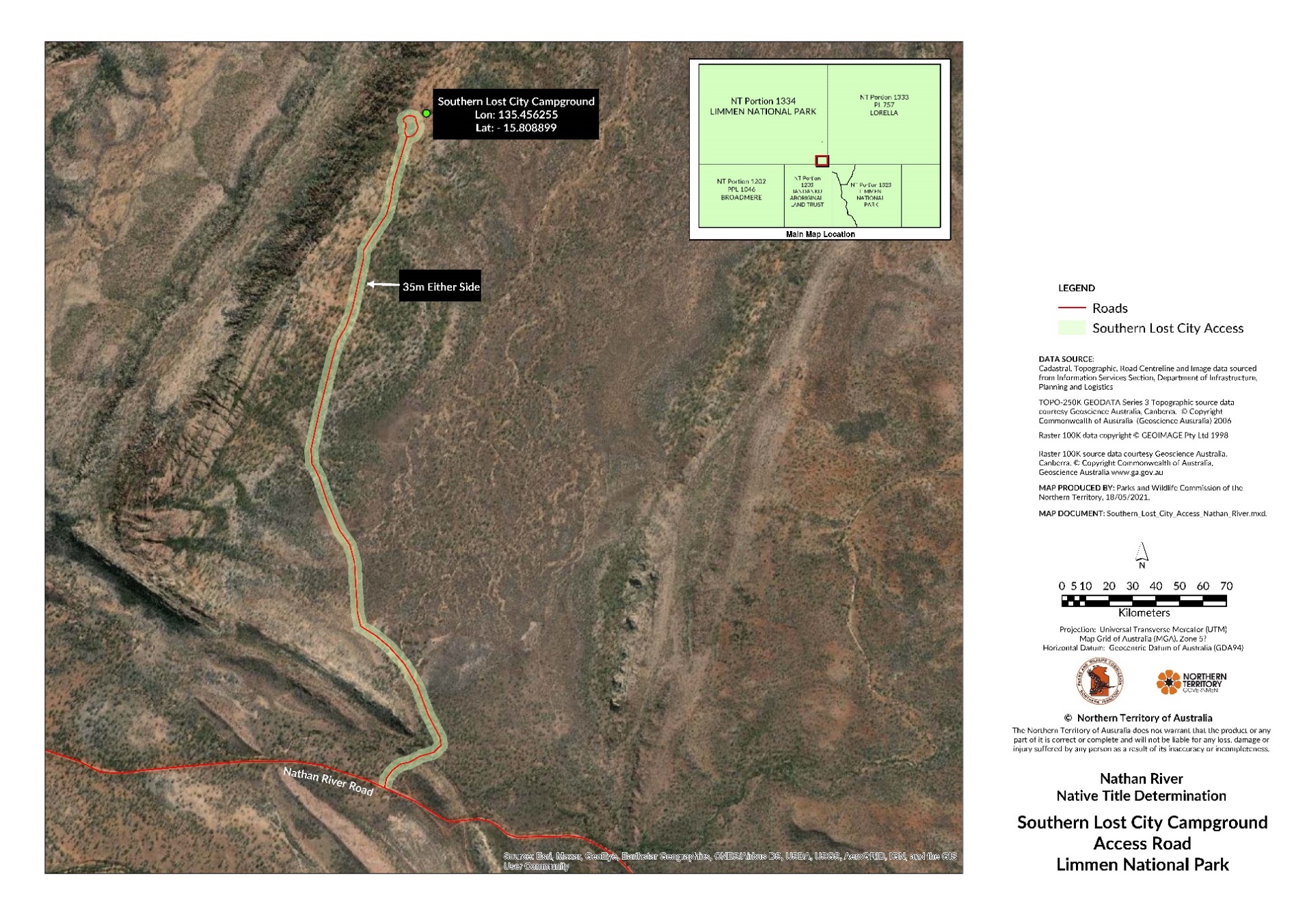
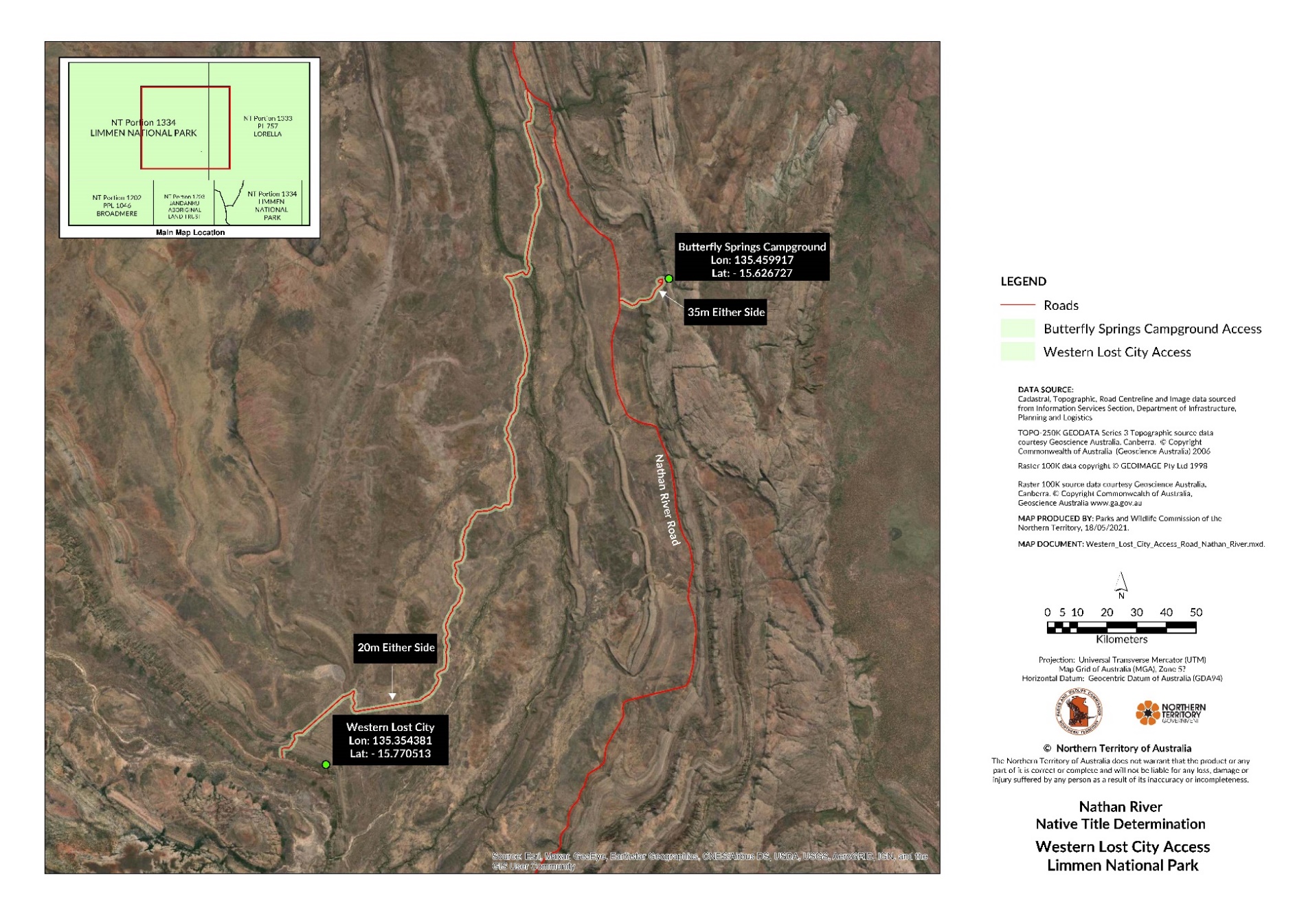
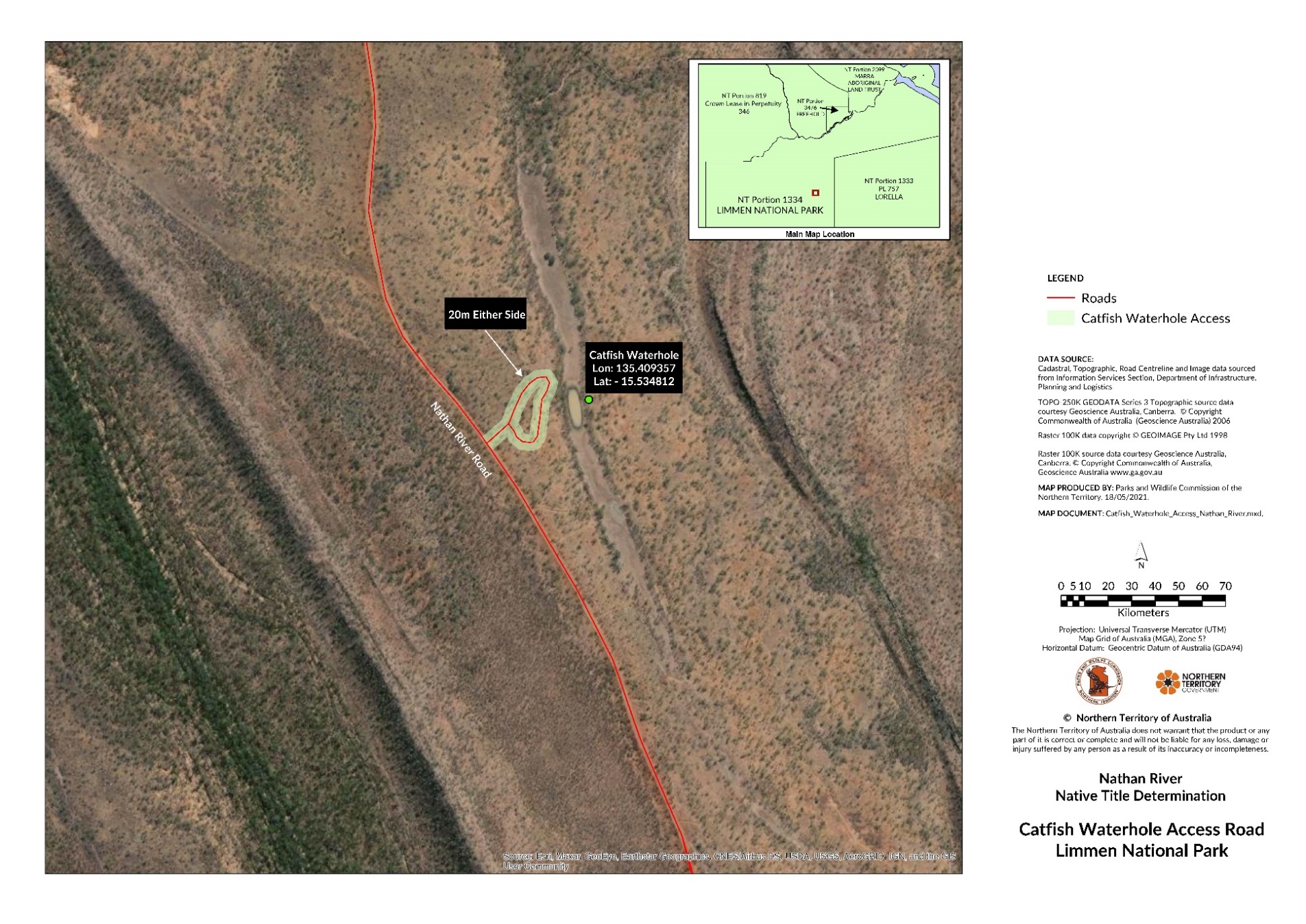
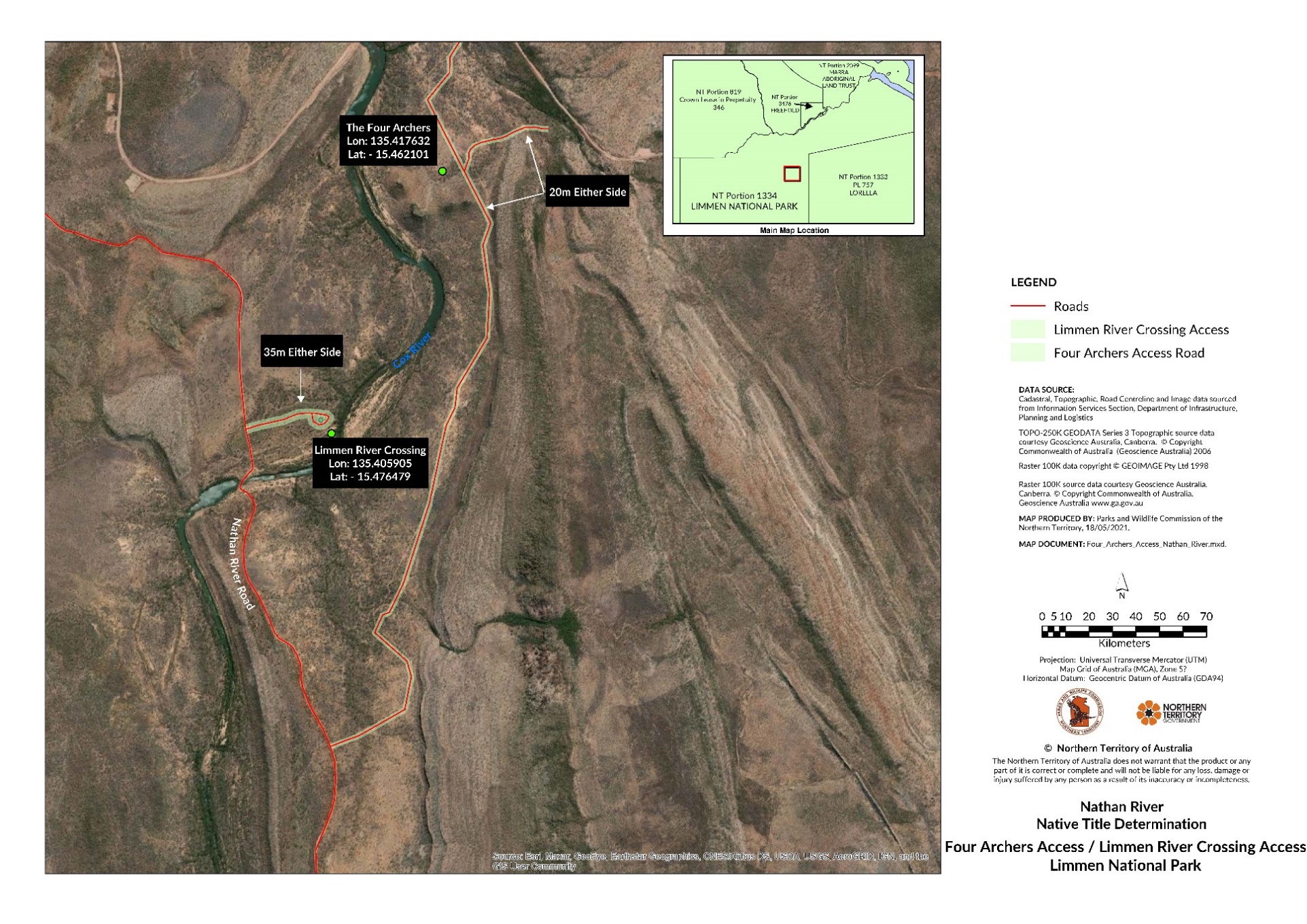
SCHEDULE F
Map of interests granted under the Mineral Titles Act (NT) and the Petroleum Act (NT)
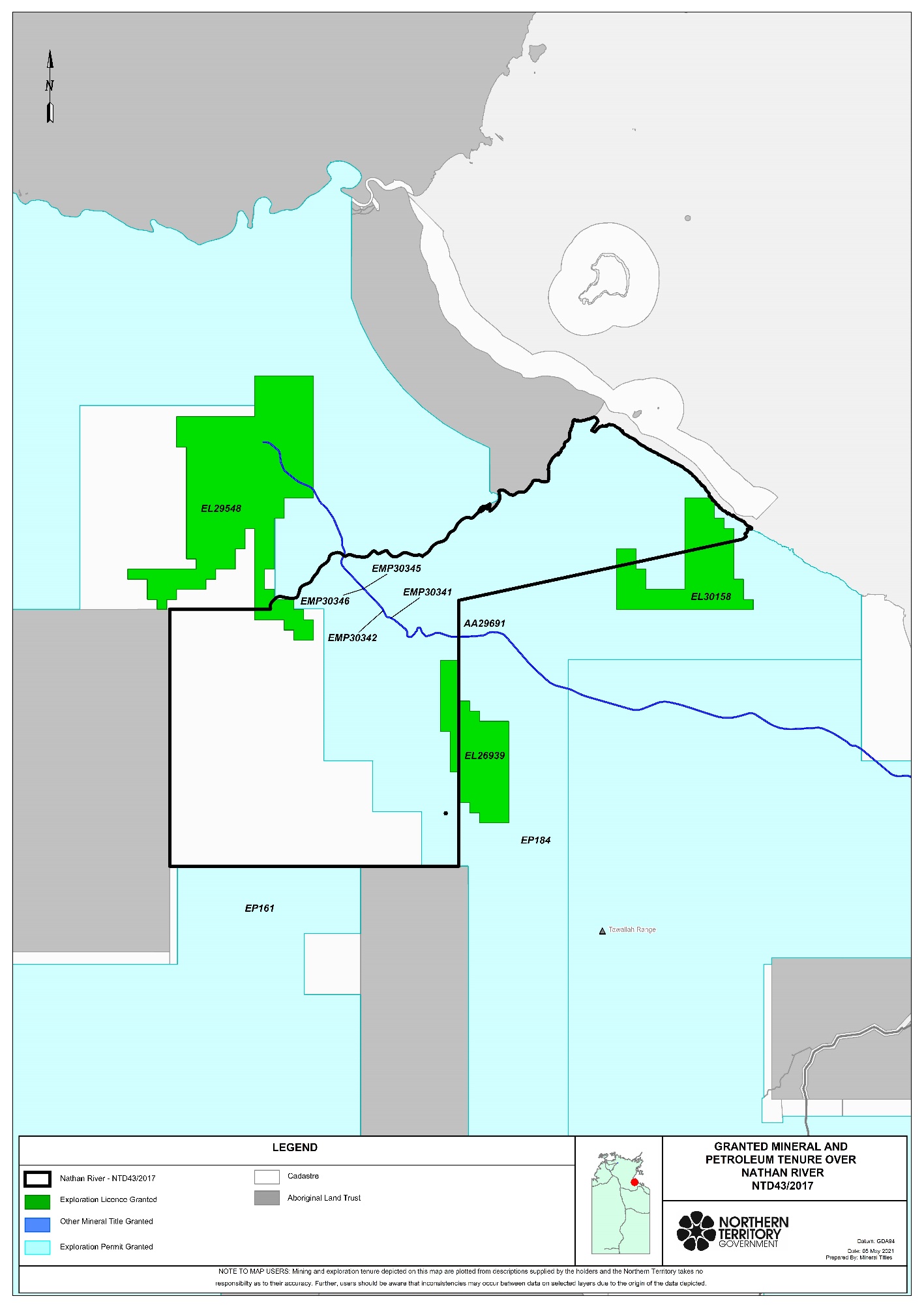
SCHEDULE G
Parties
NTD 43 of 2017 (Nathan River Pastoral Lease) | |
Applicants: | |
Second Applicant: | Grace Daniels |
Third Applicant: | Yvonne Forrest |
Fourth Applicant: | Damien Tonson |
Fifth Applicant: | Julie Limmen |
Sixth Applicant: | Denis Watson |
Seventh Applicant: | David John |
Respondents: | |
Second Respondent: | Imperial Oil & Gas Pty Ltd (ACN 92 002 699 578) |
WHITE J:
1 On 1 August 2017, the Applicant filed an application for a determination of native title over the land and waters within the boundaries of the former Nathan River Pastoral Lease (Perpetual Pastoral Lease No. 756). The parties have now agreed that a determination of native title over the area of the former Nathan River Pastoral Lease may be made by consent and apply to the Court, under s 87 of the Native Title Act 1993 (Cth) (the NT Act), for such a determination.
2 The Applicant filed an amended application on 23 September 2020 and a further amended application on 12 May 2021.
3 The Nathan River Lease area is approximately 3,690 km2 and is located in the Gulf region of the Northern Territory. It was declared part of the Limmen National Park in July 2012 and the pastoral lease was surrendered in June 2014. It is nevertheless convenient to continue to refer to the application by the name by which it has been known in the Court, namely, the “Nathan River Pastoral Lease Claim”.
4 I am satisfied that it is appropriate to make the determination sought by the parties. I set out my reasons for that conclusion below.
Section 87 of the NT Act
5 Section 87 of the NT Act permits the Court to make a determination by consent if it is satisfied that:
(a) the period specified in the notice given by the Native Title Registrar under s 66 has ended (s 87(1));
(b) there is agreement by all parties to the proceeding on the terms of a determination of native title in respect of a claim area (s 87(1)(a));
(c) the terms of the proposed determination are in writing and have been signed by or on behalf of the parties, and a copy filed with the Court (s 87(1)(b));
(d) an order in, or consistent with, the agreed terms would be within the Court’s power (s 87(1)(c)); and
(e) it is appropriate to make the determination (s 87(1A)).
Approach to the application of s 87
6 An evident policy of the NT Act is the encouragement of parties to reach agreement with respect to claims for native title, without the necessity for a formal trial. Sections 87 and 87A reflect that policy by permitting the Court to give effect to the parties’ agreement without itself conducting a trial of the merits of an application.
7 As a determination of native title binds not only the parties to the proceeding in which it is made, but everyone else in the community, the NT Act also requires the Court to be satisfied that the determination which the parties ask it to make by consent is supportable and is in accordance with the law: Cox on behalf of the Yungngora People v State of Western Australia [2007] FCA 588 at [3].
8 The approach of the Court in these circumstances has been described in a number of cases. In Lovett on behalf of the Gunditjmara People v State of Victoria [2007] FCA 474, North J said:
[36] The focus of [s 87] is on the making of an agreement by the parties. This reflects the importance placed by the Act on mediation as the primary means of resolving native title applications. Indeed, Parliament has established the National Native Title Tribunal with the function of conducting mediations in such cases. The Act is designed to encourage parties to take responsibility for resolving proceedings without the need for litigation. Section 87 must be construed in this context. The power must be exercised flexibly and with regard to the purpose for which the section is designed.
[37] In this context, when the Court is examining the appropriateness of an agreement, it is not required to examine whether the agreement is grounded on a factual basis which would satisfy the Court at a hearing of the application. The primary consideration of the Court is to determine whether there is an agreement and whether it was freely entered into on an informed basis … Insofar as this latter consideration applies to a State party, it will require the Court to be satisfied that the State party has taken steps to satisfy itself that there is a credible basis for an application … There is a question as to how far a State party is required to investigate in order to satisfy itself of a credible basis for an application. One reason for the often inordinate time taken to resolve some of these cases is the overly demanding nature of the investigation conducted by State parties. The scope of these investigations demanded by some States is reflected in the complex connection guidelines published by some States.
[38] The power conferred by the Act on the Court to approve agreements is given in order to avoid lengthy hearings before the Court. The Act does not intend to substitute a trial, in effect, conducted by State parties for a trial before the Court. Thus, something significantly less than the material necessary to justify a judicial determination is sufficient to satisfy a State party of a credible basis for an application. The Act contemplates a more flexible process than is often undertaken in some cases. These comments relate to the requirements of s 87, and are not intended to reflect on the conduct of the State in this case.
(Citations omitted)
9 As is apparent, North J emphasised the role of the relevant State or Territory in investigating and assessing claims for determinations of native title, and the weight which the Court is entitled, when considering applications under ss 87 and 87A, to give to the State or Territory’s evaluation of claim and its consent to the determination.
10 In Nelson v Northern Territory of Australia [2010] FCA 1343; (2010) 190 FCR 344 at [12]-[13], Reeves J referred to the significance of the role of the State or Territory in agreements leading to proposed consent determinations. His Honour said:
[12] It is appropriate to make some comments about the difficult balance a State party needs to strike between its role in protecting the community’s interests, including the stringency of the processes it follows in assessing the underlying evidence going to the existence of native title, and its role in the native title system as a whole, to ensure that it, like the Court and all other parties, takes a flexible approach that is aimed at facilitating negotiation and achieving agreement. In Lovett North J commented:
… There is a question as to how far a State party is required to investigate in order to satisfy itself of a credible basis for an application. One reason for the often inordinate time taken to resolve some of these cases is the overly demanding nature of the investigation conducted by State parties. The scope of these investigations demanded by some States is reflected in the complex connection guidelines published by some States.
The power conferred by the Act on the Court to approve agreements is given in order to avoid lengthy hearings before the Court. The Act does not intend to substitute a trial, in effect, conducted by State parties for a trial before the Court. Thus, something significantly less than the material necessary to justify a judicial determination is sufficient to satisfy a State party of a credible basis for an application. The Act contemplates a more flexible process than is often undertaken in some cases.
[13] I respectfully agree with North J in these observations. In my view, it would be perverse to replace a trial before the Court with a trial conducted by the State party respondent and I do not consider that is what is intended by the provisions of s 87 of the Act.
11 Madgwick J emphasised the responsibility of the State or Territory in assessing claims for native title in Smith v Western Australia [2000] FCA 1249; (2000) 104 FCR 494 at [38]:
… State governments are necessarily obliged to subject claims for native title over lands and waters owned and occupied by the State and State agencies, to scrutiny just as carefully as the community would expect in relation to claims by non-Aborigines to significant rights over such land. The State is faced with a good many such claims. A deal of proper caution is to be expected …
12 Finally, the following passage in the reasons of Keane CJ in King on behalf of the Eringa Native Title Claim Group v State of South Australia [2011] FCA 1386; (2011) 285 ALR 454 at [19] has been influential:
More recently, the Court has been prepared to rely upon the processes of the relevant State or Territory about the requirements of s 223 being met to be satisfied that the making of the agreed orders is appropriate. That is because each State and Territory has developed a protocol or procedure by which it determines whether native title (as defined in s 223) has been established. It acts in the public interest and as the public guardian in doing so. It has access to anthropological, and where appropriate, archaeological, historical and linguistic expertise. It has a legal team to manage and supervise the testing as to the existence of native title in the claimant group. Although the Court must, of course, preserve to itself the question whether it is satisfied that the proposed orders are appropriate in the circumstances of each particular application, generally the Court reaches the required satisfaction by reliance upon those processes. They are commonly explained in the joint submissions of the parties in support of the orders agreed …
13 The approach set out in these passages has been applied by the Court in a number of cases and I am satisfied that it is appropriate to apply it presently.
Consideration
14 The Joint Written Submissions and the Joint Statement of Agreed Facts provided by the Applicant and the Northern Territory indicate that regard has been had to an extensive range of material. In particular, they indicate that, in mid-2017, the Applicant provided to the Northern Territory a short-form anthropological report prepared by the anthropologist, Dr Stephen Bennetts, that identified the Aboriginal groups which, under traditional laws acknowledged and the traditional customs observed, possess primary and secondary rights in the claim area, the nature and extent of those rights, matters of connection and site and dreaming tracks. The Territory assessed Dr Bennetts’ report and referred it to Professor Basil Sansom for review. The parties then considered matters raised by Professor Sansom as well as other issues.
15 On 10 February 2018, the Applicant provided to the Northern Territory a second anthropological report from Dr Bennetts, an anthropological report from Mr Stead, who had also been retained by the Applicant, concerning a large area including the area of the Nathan River Pastoral Lease, and witness statements from two senior claimants, Walter Golbong Rogers and Gordon Nawundulpi.
16 In the preparation of their reports, the anthropologists drew on an extensive amount of material including material contained in five reports of the Aboriginal Land Commissioner prepared under the Aboriginal Land Rights (Northern Territory) Act 1976.
17 The Applicant and the Northern Territory then engaged in further evaluation of the claim which led to the Applicant providing the Northern Territory with the report of Ms Gay English, an anthropologist, in March 2020. Ms English’s report related to the description of the Mambali Walangara estate group.
18 As a result of the consideration of all the material, the Applicant and the Northern Territory are agreed that the native title claim group is comprised of persons who hold native title rights and interests in the determination area and have agreed upon the content of those rights and interests.
19 The Northern Territory has extracted details of tenure within the determination area and they too have been the subject of agreement.
20 The second respondent does not dispute any of the matters on which the Applicant and the Northern Territory have greed.
21 I am satisfied that each of the “procedural” requirements of s 87 has been satisfied: the period specified in the notice issued by the Native Title Registrar under s 66 has expired; each of the current parties to the proceeding is a party to the agreement; the terms of the proposed determination have been reduced to writing and signed by or on behalf of each party; and the terms of the agreement have been filed in the Court. The proposed determination is to be made on an application which is valid under the NT Act and is within the Court’s jurisdiction under s 61 of the NT Act.
22 Section 94A of the NT Act requires that an order of the Court determining a native title claim set out details of the matters mentioned in s 225. Section 225 provides:
225 Determination of native title
A determination of native title is a determination whether or not native title exists in relation to a particular area (the determination area) of land or waters and, if it does exist, a determination of:
(a) who the persons, or each group of persons, holding the common or group rights comprising the native title are; and
(b) the nature and extent of the native title rights and interests in relation to the determination area; and
(c) the nature and extent of any other interests in relation to the determination area; and
(d) the relationship between the rights and interests in paragraphs (b) and (c) (taking into account the effect of this Act); and
(e) to the extent that the land or waters in the determination area are not covered by a non-exclusive agricultural lease or a non-exclusive pastoral lease—whether the native title rights and interests confer possession, occupation, use and enjoyment of that land or waters on the native title holders to the exclusion of all others.
Note: The determination may deal with the matters in paragraphs (c) and (d) by referring to a particular kind or particular kinds of non-native title interests.
23 The requirements of s 223(1) were considered by the High Court in Members of the Yorta Yorta Aboriginal Community v Victoria [2002] HCA 58; (2002) 214 CLR 422. The relevant principles were also reviewed by Mansfield J in Risk v Northern Territory of Australia [2006] FCA 404. Those principles require that there be a recognisable group or society which presently recognises and observes traditional laws and customs in the area of the proposed determination.
24 The parties are agreed that eight estate groups hold native title rights and interests in the determination area:
(a) the Guyal Manaburru estate group;
(b) the Burdal Mingkanyi estate group;
(c) the Burdal Riley estate group;
(d) the Murrungun Wunubari estate group;
(e) the Murrungun Baluganda/Langgabany estate group;
(f) the Mambali Walangara estate group;
(g) the Mambali Ngubayin estate group; and
(h) the Mambali Nangguya estate group.
25 The agreed facts identify the apical ancestors from whom each estate group is descended. It also contains details of the knowledge of the estate groups of the land, their responsibility for it, as well as other matters supporting their connection to the land.
26 I am satisfied that the proposed determination satisfies the elements of s 225 as required by s 94A of the NT Act. Clause 1 and Schedules A and B set out with appropriate particularity the area in which native title exists. Clauses 5-6 define the group of native title holders and the criteria by which group membership is determined. Clauses 7-8 indicate that the members of neighbouring estates also have native title rights and interests in the determination area but those rights and interest are subject to those of the estate groups.
27 Clauses 9-13 set out the nature of the native rights and interests in the determination area. Clause 15 sets out in an appropriate way the nature and extent of the other interests in the determination area and clauses 16 and 17 define the relationship of those “other interests” with the determined native title rights and interests.
28 By ss 55 and 56 of the NT Act, the Court must determine whether the native is to be held in trust and, if so, by whom. Order 2 specifies that the native title is not to be held in trust.
Conclusion
29 The matters reviewed above indicate that it is appropriate for the Court to make the consent determination. In addition, I take into account that the parties are legally represented and there is no reason to suppose that any party has been disadvantaged by a lack of legal representation. There are no other proceedings before the Court relating to native title determination applications over the area which is the subject of the proposed determination.
30 Accordingly, I make the orders in the terms proposed by the parties. In doing so, I emphasise that the order of the Court does not amount to a grant of native title to the estate holders. The order is instead a public and formal recognition that the native title rights and interests of the estate groups exist, and have always existed, at least since European settlement.
I certify that the preceding thirty (30) numbered paragraphs are a true copy of the Reasons for Judgment of the Honourable Justice White. |
Associate:




